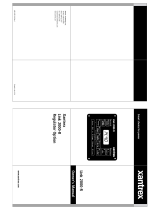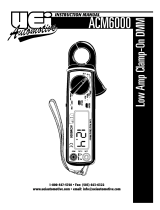Page is loading ...

Table of Contents
Section A: Alternator and Regulator ............................ 2
Electromagnetic Interference (EMI) ............. 2
Section B: Schematic Diagram ..................................... 3
Section C: On-Vehicle Troubleshooting ......................... 4
Testing Guidelines
Professional service technicians rely on the following
guidelines when testing electrical components.
Voltage testing:
• Set meter to proper scale and type (AC or DC).
• Be sure to zero the meter scale or identify the meter
burden by touching meter leads together. Meter bur-
den must be subtracted from final reading obtained.
• Be sure the meter leads touch source area only.
Prevent short circuit damage to test leads or source
by not allowing meter leads to touch other pins or
exposed wires in test area.
• Be sure to use CEN tools designed especially for
troubleshooting CEN alternators when available.
See page 1 for more information.
Resistance (ohm) testing:
• Set meter to proper scale.
• Be sure to zero the meter scale or identify the meter
burden by touching meter leads together. Meter bur-
den must be subtracted from final reading obtained.
• Be sure the meter leads touch source area only.
Prevent altering the reading by not allowing fingers
or body parts to touch meter leads or source during
reading.
• Be sure reading is taken when source is at 70ºF.
Readings taken at higher temperatures will increase
the reading. Conversely, readings taken at lower
temperatures will decrease the reading.
• Be sure to test directly at the source. Testing through
extended harnesses or cable extensions may increase
the reading.
Voltage drop testing:
• Measure voltage between B+ on alternator or source
and B- (ground) on alternator or source. Record
obtained reading. Move to batteries or other source
and measure again between B+ and B- terminals on
battery or other source. Difference between the two
readings represents voltage lost within the circuit
due to but not limited to inadequate cable gage or
faulty connections.
• Voltage drop measurements must be taken with
all electrical loads or source operating.
Dynamic/Live testing:
Definition: Connecting power and ground to a
component to test operation/function out of circuit.
1. Be sure to connect jumper leads directly and securely
to source contacts of the component being tested.
2. Be sure to make any connection to power and ground
at the power supply or battery source terminals. Do
not make connection at component source terminals
as that may create an arc and damage component
source terminals.
WARNING
Hazard Defi nitions
These terms are used to bring attention to presence of hazards
of various risk levels or to important information concerning
product life.
Indicates presence of hazard(s) that
can cause severe personal injury,
death, or substantial property
damage if ignored.
Indicates presence of hazards that
will or can cause minor personal
injury or property damage.
CAUTION
Tools and Equipment
• Digital Multimeter (DMM)
• Ammeter (digital, inductive)
• Jumper wires
• CEN 5-pin Metri-Pack Inline Harness Test Tool A10-115
Figure 1—CEN 5-pin Metri-Pack Inline Harness
Test Tool A10-115
Before troubleshooting any CEN products, the service technician should:
• read, understand, and agree to follow all information contained in this troubleshooting guide.
• understand the operational characteristics of the electrical charging system components to be tested.
• be profi cient at the use of tools and test equipment used in troubleshooting CEN products.
WARNING
Page 1
TG75B
C613, C615, C620, C623, and C634 Alternators
On-Vehicle Troubleshooting Guide
C.E. Niehoff & Co.

Page 2 TG75B
Section A: Alternator and Regulator
CEN C613, C615, C620, C623, and C634 Alternators with A2-128 Regulator
C613 (14 V, 290 A), C615 (14 V, 340 A), C620 (14 V, 340 A), C623 (14 V, 290 A), and C634 (14 V, 350 A) alternators
are internally rectified. All windings and current-transmitting components are non-moving, so there are no brushes
or slip rings to wear out.
These alternators are externally energized when the battery master switch on the vehicle is turned on and provides:
• power to the regulator at its IGN terminal.
• field coil power supply from the battery through the F+ terminal on the regulator. If a battery isolator is used in
the system, the F+ terminal must be connected directly to the B+ terminal on the battery. If a battery isolator is
not used in the system, the F+ terminal must be jumpered to the alternator B+ terminal so that the field circuit
becomes activated.
AC is then rectified into DC output through diodes in drive end housing and supplied to the battery from the alternator
B+ terminal. See Figure 4 on page 3. Regulator maintains alternator output voltage at pre-determined regulated setting
(see below for setpoints) as vehicle electrical loads are switched on and off.
A2-128 regulator used with all units is designed to limit output current so output current will not exceed rated capacity
of alternator. Regulator has a P terminal for optional AC voltage tap. P terminal signal frequency (Hz) x 10 = alternator
shaft rpm.
Regulator fixed (flat temperature compensation) setpoints shown in Table 1 are selected based on battery type. Battery
type selection and battery maintenance/function are the sole responsibilities of the customer.
Figure 2—Voltage Setpoints
1234
Electromagnetic interference (EMI) is suppressed with internal filters to acceptable levels defined by the Society of
Automotive Engineers (SAE) specification J1113/41. C613, C615, C620, C623, and C634 alternators and A2-128 regulator
have demonstrated electromagnetic compliance (or compatibility) by being tested in accordance to the limits defined by
SAE J1113/41 standards for EMI suppression. However, these alternators and regulator will not reduce EMI from
sources such as;
• vehicle digital systems
• wireless links
• digital devices
• antennas
• poor cable routing practice
• improper vehicle wiring
• battery imbalance
...and other sources that cause EMI.
If EMI continues after addressing the above conditions, consult an electromagnetic compliance (or compatibility) special-
ist to determine EMI source and potential resolutions.
Table 1— Voltage Setpoint Switch Position
Voltage Setpoints (±0.2 V) Battery Type
Position 1 14.0 V Maintenance (D Category)
Position 2 14.4 V Maintenance-free (Group 31)*
Position 3 14.8 V Maintenance-free (Group 31)*
Position 4 15.5 V Battery Isolator Setpoint
* Group 31 batteries: If boiling or excessive gassing occurs with high voltage
setpoint (position 3), change to medium voltage setpoint (position 2).

Page 3
TG75B
Figure 4—Alternator Schematic Diagram
Section B: Schematic Diagram
Figure 3—Alternator with A2-128 Regulator
B– Terminal
B+ Terminal
IGN Terminal
P Terminal
F+ Terminal
B+
B–
ALTERNATOR
RECTIFIER
FIELD
REGULATOR
LOAD
BATTERY
STATOR
STATOR
ENERGIZE
SWITCH
IGN P
E
D
C
B
A
F+
BR
R
BK
G
W

Page 4 TG75B
Section C: On-Vehicle Troubleshooting
Yes No
Is there a battery isolator in the system?
No Alternator Output – Test Charging Circuit
MASTER BATTERY SWITCH ON, KEY ON, ENGINE ON: Test for battery voltage at B+ terminal on alternator
to ground, then at F+ terminal on regulator to ground, and finally at IGN terminal on regulator to ground.
Does battery voltage exist at all three locations?
Yes No
MASTER BATTERY SWITCH ON, KEY ON, ENGINE OFF: Install one jumper wire from B+ terminal on alterna-
tor to F+ terminal on regulator. Add second jumper wire from B+ terminal on alternator to IGN terminal on
regulator. Touch shaft with steel tool to detect significant magnetism. Is shaft magnetized?
Yes No
Figure 5 – A10-115 Inline
Harness Tool Socket
Connections
SOCKET CONNECTIONS
Socket A B–
Socket B Field +
Socket C Field –
Socket D Phase (R)
Socket E B+
Test field circuit. Readings of all three tests must pass:
1. Battery voltage test: Connect DMM red lead to socket E in test tool. Connect DMM black lead to socket A in test
tool. Battery voltage should exist.
2. Field coil resistance test: Set DMM on Ohms test. Field resistance measured between sockets B and C in test tool
should measure nominal 1.2 ± 0.2 ohms. Field coil is defective if reading is less than 0.5 ohms or greater than 3 ohms.
3. Significant magnetism test:
a. Securely connect one jumper wire between sockets B and E in test tool.
b. Securely connect one end of a second jumper wire to socket C on the test tool.
c. Momentarily (1 sec.) touch other end of second jumper wire to ground on alternator case. Spark will occur at
ground on alternator case. Touch steel tool to shaft to detect significant magnetism.
Run engine and re-test charging circuit.
Is charging system performing properly?
System is operative.
Yes No
Yes No
Alternator is defective.
Remove both jumper wires. Disconnect alternator-
to-regulator harness plug at regulator and connect
CEN A10-115 inline test tool to harness plug end
only. Make sure connections are secure.
If you have questions about your alternator or any of these test procedures, or if you need to locate a Factory Authorized Service Dealer, please contact us at:
C.E. Niehoff & Co.• 2021 Lee Street • Evanston, IL 60202 USA
TEL: 800.643.4633 USA and Canada • TEL: 847.866.6030 outside USA and Canada • FAX: 847.492.1242
E-mail us at service@CENiehoff.com
Before starting diagnostic sequence, verify the following and repair/replace if not to spec:
• batteries for state-of-charge (12.3-12.6 V), condition, and secure connections
• master battery switch for function
Install temporary jumper between one battery terminal and alternator
terminal on isolator. Use minimum 12 AWG wire.
CAUTION Do not operate charging system more than two minutes
with jumper installed. Charging system voltage will be
abnormally high and damage other components.
Regulator is defective.
Repair vehicle wiring as necessary. Run engine and re-test
charging circuit. Is charging system performing properly?
System is operative.
Yes No
ABCDE
/




